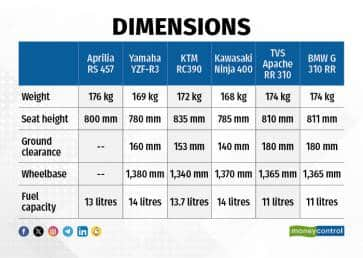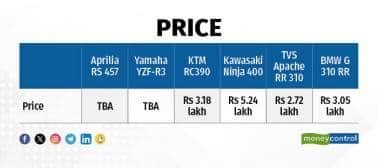



With the launch of the Aprilia RS 457 and the Yamaha YZF-R3 motorcycles just around the corner, competition in the 400cc supersport segment is heating up. Of course, it is already pretty toasty with the likes of the KTM RC390, the BMW G 310 RR, the Kawasaki Ninja 400 and even the TVS Apache RR 310 already in the market. But how do the newcomers stack up against the current rides and will they even make a dent in this already established market?
Okay, it may be a little misleading to call the Yamaha R3 a newcomer, seeing that the bike was available in India until new emission norms kicked in. The RS 457, on the other hand, is an all-new bike, but it comes from a big Italian marquee, a favourite among many motorcycle enthusiasts around the world.
Moving on to the real subject matter. While we usually start with design, this is a subjective concept and opinions may not be unanimous. All these bikes are supersport bikes, so they all have a fairly committed riding stance and proper sport bike styling. This means a full fairing in the front, a big round fuel tank in the centre and a step-up seat setup that allows for an upswept tail section.
While all bikes have LED lighting, the KTM RC390 is the only bike with a single unit while the others feature a split headlamp. The Kawasaki Ninja 400, on the other hand, is the only bike that gets a semi-digital dash, while the Yamaha R3 is a black-and-white LCD display.
 From the table, it is easy to tell that the Aprilia is the most powerful bike in this line-up, producing a maximum of 46.7 hp.
From the table, it is easy to tell that the Aprilia is the most powerful bike in this line-up, producing a maximum of 46.7 hp.From the table, it is easy to tell that the Aprilia is the most powerful bike in this line-up, producing a maximum of 46.7 hp. Sure, it may only be a little over a horsepower higher than the Ninja’s 45 hp max, but the Aprilia’s 43.5 Nm peak torque output far outclasses every other bike here by a mile.
At the bottom of the pool are the TVS Apache RR 310 and the BMW G 310 RR. These are essentially the same bike built under the TVS-BMW partnership and as such get the same 321cc engine that generates an identical 34 hp and 27.3 Nm.
The Yamaha R3’s 321cc is no slouch either, producing 42 hp of maximum power and bringing it in closer competition to the KTM RC390’s 43.5 hp. But this comes at the cost of its torque output, which measures 29.5 Nm.
 The Kawasaki Ninja 400 is the lightest bike, weighing in at 168 kg, while the Yamaha is only a kilo heavier at 169 kg.
The Kawasaki Ninja 400 is the lightest bike, weighing in at 168 kg, while the Yamaha is only a kilo heavier at 169 kg.The Kawasaki Ninja 400 is the lightest bike, weighing in at 168 kg, while the Yamaha is only a kilo heavier at 169 kg. The heaviest is the Aprilia – 176 kg and this could translate directly to how different the Ninja feels against the RS 457.
The Kawasaki also has the shortest seat height at 785 mm, meaning the little green Kawi is the easiest choice for shorter riders. But while not ideal for the tallest of people, the Ninja is an extremely comfortable bike with a more upright riding position than most supersport bikes.
The KTM, on the other hand, has the tallest seat height, so if you’re a little insecure with a tall seat, this may not be the way to go. However, the KTM will likely be the most comfortable for taller riders with enough legroom to spare.
 You’ll notice that there’s very little to differentiate the parts, save for the brakes, with the KTM and the Aprilia getting the biggest front disc measuring 320 mm, while the TVS and the BMW get the largest rear brake at 240 mm.
You’ll notice that there’s very little to differentiate the parts, save for the brakes, with the KTM and the Aprilia getting the biggest front disc measuring 320 mm, while the TVS and the BMW get the largest rear brake at 240 mm.You’ll notice that there’s very little to differentiate the parts, save for the brakes, with the KTM and the Aprilia getting the biggest front disc measuring 320 mm, while the TVS and the BMW get the largest rear brake at 240 mm. Two bikes, however, have the biggest differences.
First, the Kawasaki gets a conventional telescopic front fork, unlike the better-performing upside-down forks that come standard on all the other bikes. The second is the RR 310’s tyre specs. It receives the same 17-inchers like the rest. However, unlike the R specification on the other bikes, the Apache gets ZR spec.
This ZR rating is an indicator that the tyre was developed for high-speed operation capabilities. While R-rated tyres can operate best at speeds up to 170 km/h, the ZR, or performance-rated, tyre can operate even at speeds above 239 km/h. Just remember to take your bike to the track if you actually want to do those speeds, though.
 The Aprilia will be manufactured at the company’s Baramati plant in India, which means they should be able to slap a lower price tag as compared to if they had opted to import the bikes.
The Aprilia will be manufactured at the company’s Baramati plant in India, which means they should be able to slap a lower price tag as compared to if they had opted to import the bikes.While we wait for the prices of the Aprilia and the Yamaha to be announced, we know the Kawasaki is the most expensive here. This is unlikely to change. The Aprilia will be manufactured at the company’s Baramati plant in India, which means they should be able to slap a lower price tag as compared to if they had opted to import the bikes. Safe to say, however, that both the Aprilia and the Yamaha will likely be priced nearer to the Rs 4 lakh mark, bridging that gap between the KTM’s R 3.18 lakh starting price tag and the Ninja’s Rs 5.24 lakh sticker. The TVS Apache RR 310 is the most affordable ride here, starting at Rs 2.72 lakh.
However, there are a number of optional extras that allow the bike to compete technologically with the rest of the stable and this brings it closer to the BMW G 310 RR’s Rs 3.05 lakh price tag.
Discover the latest Business News, Sensex, and Nifty updates. Obtain Personal Finance insights, tax queries, and expert opinions on Moneycontrol or download the Moneycontrol App to stay updated!
Find the best of Al News in one place, specially curated for you every weekend.
Stay on top of the latest tech trends and biggest startup news.